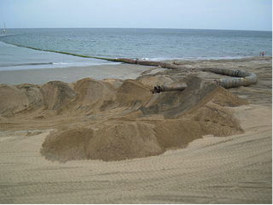Cost-Benefit Analysis
How can stakeholders’ choose among these strategies?
One of the most frequently used methods for determining which strategies communities should use to prepare for sea level rise is cost-benefit analysis. Cost-benefit analysis is a systematic approach to decision-making that compares alternatives based on their ratio of benefits to costs. For example, imagine a community is choosing between managed retreat and beach nourishment/restoration as options for protecting a coastal development from sea level rise and other coastal hazards over the next ten years. For the managed retreat option, relocating homes and businesses further inland and converting coastal areas to parkland is expected to cost $4 billion, but the associated reduction in vulnerability and increased tourism from the new parks is expected to bring $6 billion in benefits over the next ten years. The ratio of benefits to costs for the managed retreat option would therefore be 6/4, or 1.5. For the beach nourishment/restoration option, adding millions of tons of sand to the beach is expected to cost $2 billion over ten years but will also bring $4 billion in benefits by reducing vulnerability and improving the recreational value of area beaches, for a benefit to cost ratio of 4/2, or 2. Because the ratio of benefits to costs for the next ten years is higher for the beach nourishment/restoration option (2) than for the managed retreat option (1.5), cost-benefit analysis suggests that, at least for the next decade, beach nourishment/restoration is the better strategy for protecting the community.
| - |
Managed Retreat  |
Beach Nourishment/Restoration  |
|---|---|---|
| Total Costs | $4 billion | $2 billion |
| Total Benefits | $6 billion | $4 billion |
| Benefits/Cost Ratio | 1.5 | 2.0 |
Types of costs and benefits
As this example suggests, strategies for preparing for sea level rise can have many different types of costs and benefits, including changes to vulnerability and the local economy. The table below summarizes some of these possible costs and benefits.
| Possible Costs | Possible Benefits |
|---|---|
| New or continuing construction, maintenance, and operation costs | Avoided construction, maintenance, and operation costs |
| Economic costs | Economic benefits |
| Residual or increased vulnerability | Reduced vulnerability |
| Environmental degradation | Environmental benefits |
| Negative impacts on community design/livability | Improvements to community design/livability |
| Decreased equity | Increased equity |
| Inconsistency with local goals, plans | Consistency with local goals, plans |
Types of possible costs and benefits for sea level rise mitigation strategies. Adapted from “Urban Waterfront Adaptive Strategies,” City of New York Department of Planning, June 2013
This list is not exhaustive, but instead provides examples of the types of costs and benefits frequently considered when planning for sea level rise and related hazards. In a real participatory planning environment, stakeholders are often asked to brainstorm lists of possible costs and benefits, which may be more or less extensive than those listed here.
